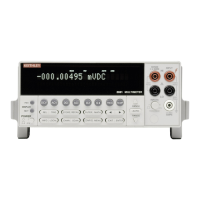IEEE-488 Reference
4-231
Programming example 10 OUTPUT 716; “:trig:tcon:asyn:ilin 3; ilin?”
20 ENTER 716; A$
30 PRINT A$
40 END
Line 10 Assigns the asynchronous Trigger Link input of the measure layer to line #3, and
then queries the programmed input line.
Line 20 Addresses the Model 2001 to talk.
Line 30 Displays the programmed input line # (3).
:OLINe <NRf>
:ARM[:SEQuence[1]][:LAYer[1]]:TCONfigure:ASYNchronous:OLINe <NRf> Select output trigger
line; arm layer
:ARM[:SEQuence[1]]:LAYer2:TCONfigure:ASYNchronous:OLINe <NRf> Select output trigger
line; scan layer
:TRIGger[:SEQuence[1]]:TCONfigure:ASYNchronous:OLINe <NRf> Select output trigger
line; measure layer
Parameters <NRf> = 1 Line #1
= 2 Line #2
= 3 Line #3
= 4 Line #4
= 5 Line #5
= 6 Line #6
Formats :arm:tcon:asyn:olin <NRf>
:arm:lay2:tcon:asyn:olin <NRf>
:trig:tcon:asyn:olin <NRf>
Defaults Power-up Saved power-on setup
*RST 1 (all layers)
:SYSTem:PRESet 1 (all layers)
Query :OLINe? Query programmed output line #
Short-form formats: :arm:tcon:asyn:olin?
:arm:lay2:tcon:asyn:olin?
:trig:tcon:asyn:olin?
Response message: 1 to 6
Description These commands are used to select an output line for the asynchronous Trigger Link of the spec-
ified layer. Keep in mind that asynchronous Trigger Link input and output cannot share the same
line. If you assign the output to a line that is already being used for the input, an error will occur
and the command will be ignored.
Programming example 10 OUTPUT 716; “:trig:tcon:asyn:olin 4; olin?”
20 ENTER 716; A$
30 PRINT A$
40 END

